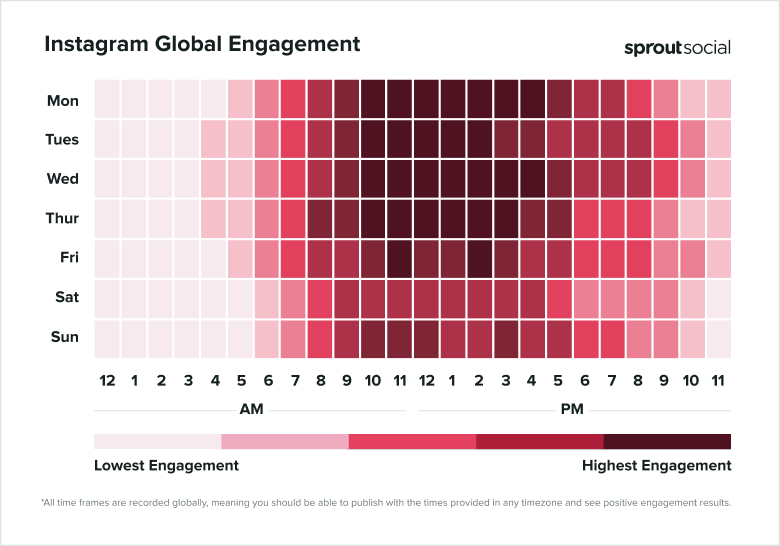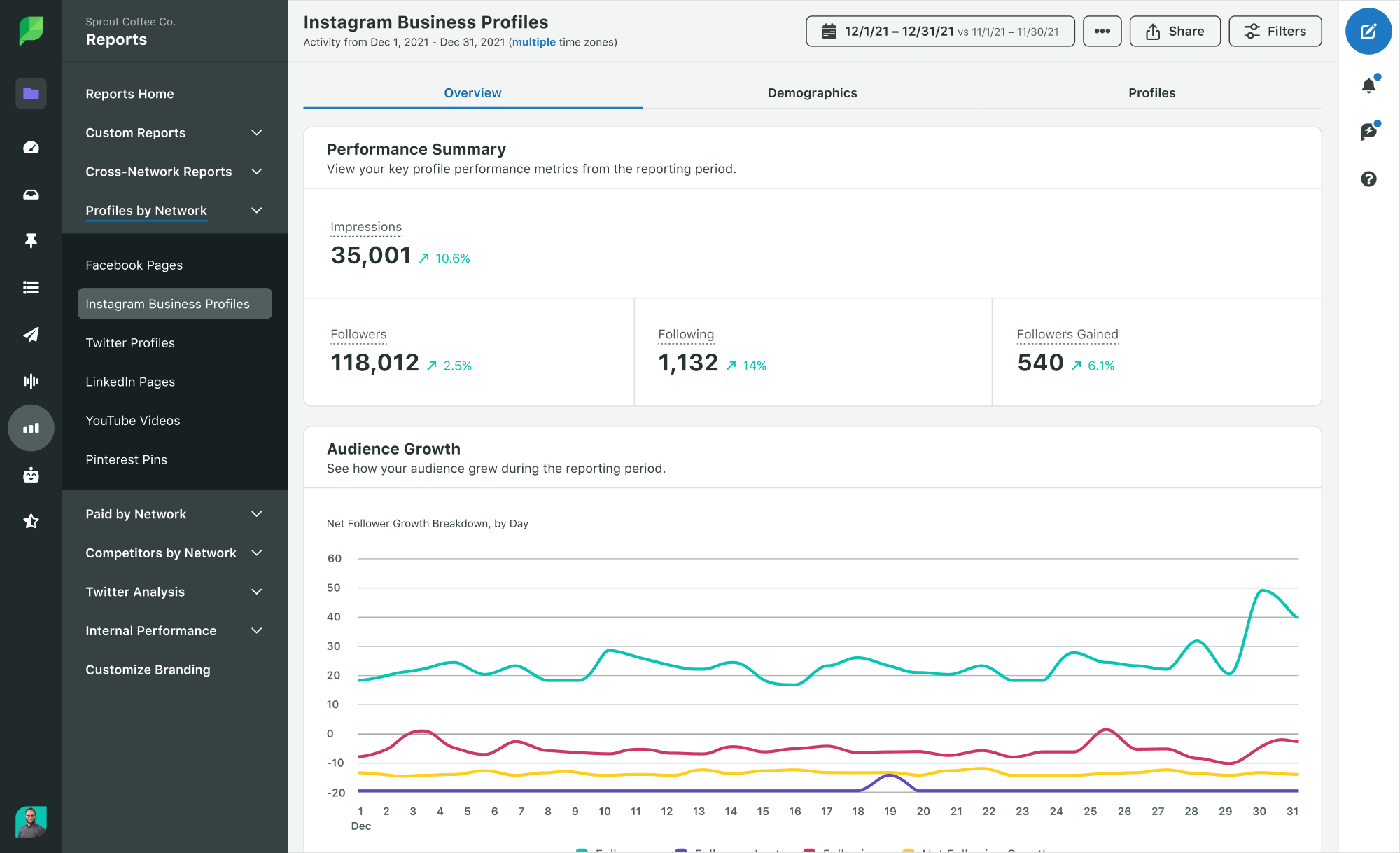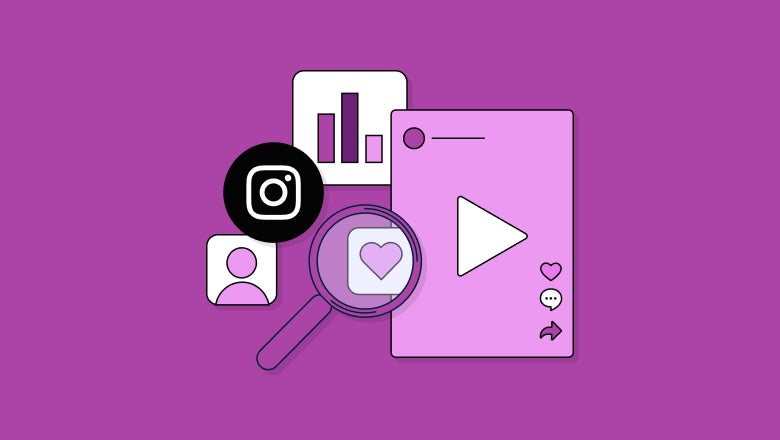
Instagram Marketing
Instagram marketing: Update your strategy for 2026
Ready to grow your brand on Instagram? This comprehensive guide gives you a clear roadmap to connect with customers and elevate your strategy.
Want to put it into practice? Start your free 30-day trial of Sprout Social and see the difference.
Reading time 15 minutes
Published on December 1, 2025

Table of Contents
Summary
- Instagram marketing starts with defining your goals and target audience. Establish what you want to achieve with Instagram (brand awareness, sales, etc.) and identify who you want to reach (potential customers).
- For businesses new to Instagram marketing, it’s important to convert to a business profile, craft a compelling bio with a call to action and link and design an eye-catching profile picture.
- A successful marketing strategy includes creating high quality content, publishing consistently, growing your followers and tracking your results to adjust your strategy accordingly.
With audiences embracing Instagram as their platform of choice, your brand needs a strong presence to drive growth. A strong Instagram marketing strategy is no longer optional—it’s essential for growth.
Instagram dominates consumer attention, with data from our 2024 Social Media Content Strategy Report showing that 84% of social users have a profile on the platform. This makes it a goldmine for businesses of all sizes looking to connect with their audience.
But standing out requires more than just photos with filters. You need a visually compelling feed and a well-defined content plan to capture attention and drive results.
You need a clear-cut, actionable Instagram marketing strategy to build your presence and attract customers. If you’re building your broader social media marketing strategy, Instagram should be a cornerstone of your approach.
This guide breaks down the essential steps for building a successful Instagram marketing strategy. Use it to launch your presence or refresh your existing approach with the latest best practices for growth.
What is Instagram marketing?
Instagram marketing is the strategy of using the platform’s features to build a community, promote your business and drive results. It encompasses everything from creating visually compelling content and engaging with your audience to leveraging Instagram’s shopping features and analytics tools. Success requires a cohesive content plan, creative audience engagement and a deep understanding of what resonates with your followers. When done right, Instagram marketing transforms your profile into a powerful channel for brand awareness, customer loyalty and revenue growth.
Why use Instagram for marketing?
Social media marketing is a wildly popular strategy as there are more than 5 billion social media users worldwide.
And Instagram is a popular choice among these users, being the most visited social media platform in the United States and second most visited globally.
Instagram is the top social media platform for product discovery. According to our 2024 Social Media Content Strategy Report, 61% of social users turn to the platform to find their next purchase.
Consumers use Instagram to follow brands, research products and inform their buying decisions, making it a critical platform for driving sales.
With a pretty solid distribution of ages and genders, you’re likely to find at least one segment of your target audience on the app.

Source: Statista
How is Instagram used for marketing?
Instagram is a visual platform with a heavy focus on photo and video. Brands and businesses can use Instagram features to creatively promote their products/services. It even allows creators to set up dedicated accounts with useful tools to market their content. Some features include:
- Carousel posts
- Instagram Stories
- Story highlights
- Instagram Reels
- Instagram Threads
- Instagram shopping
- Paid partnerships for influencer marketing campaigns
- Collab posts with other accounts
- Sponsored posts with creators and influencers
How to create an Instagram business account
Ready to get started with your own Instagram business profile? It’s easy to create one and start sharing content immediately. Let’s walk you through the process.
- Step 1: Download the Instagram app onto your smartphone. While there is a desktop version, the app is mobile-first and most tasks are easiest to complete on the mobile app.
- Step 2: Input your business email address and choose a password. Follow the instructions until you’re taken to your new profile. Instagram only lets you create a personal account first, which you’ll need to convert into a business profile.
- Step 3: Begin your visual branding. Tap on the “Edit profile” button to do this. Upload a profile photo and input all necessary profile information—your business name, bio, profile link, CTA button, etc.

- Step 4: From the “Edit profile” page, tap on the “Switch to professional account” option. This will start the process of turning your profile into a business account.

- Step 5: Select your business category and choose whether you want to create a Business or Creator account. Then review your contact info to complete the process. You can also opt to not let Instagram use your contact info in your profile.
How to create an Instagram marketing strategy
Now that we’ve outlined why you should be marketing on Instagram and how to create a business profile, let’s get to work in creating an Instagram strategy.
1. Define your Instagram marketing goals
Every effective Instagram marketing strategy starts with a clear answer to one question: Why are you on the platform? Your purpose dictates your actions. Are you there to generate leads, build a community or increase brand awareness?
Setting social media goals is an essential step in any strategy. These goals determine everything from your content strategy to how much time you need to spend on the platform to accomplish them.
There isn’t a single “right” goal. Your objectives depend entirely on your overall business goals. Ultimately, your ROI from Instagram hinges on these goals.
For example, West Elm is a shining example of a retail brand whose Instagram strategy is laser-focused on social selling. Its entire feed centers around showing off its products and encouraging followers to check them out as well. The furniture brand creates shoppable posts so shoppers can buy directly on the app. It even has a stunning Instagram storefront showcasing its products.

Source: Instagram
Meanwhile, beauty brands often focus on highlighting their products in use. They also aim to build a community by constantly going back and forth with followers.
Local, brick-and-mortar businesses want to keep customers in the loop on their latest promotions while simultaneously building relationships. Notice how Cedar Palace Chicago takes the time to respond to their customer comments in addition to showing off their mouth-watering Mediterranean food options.

Source: Instagram
And many B2B brands use the platform as a means of education. Creating branded graphics can go a long way in providing visually appealing information for your audience, like we see here from Leadpages.

Source: Instagram
The beauty of Instagram is the sheer amount of creative freedom available to you. Either way, deciding on the Instagram tactics you’ll use starts with your goals.
Dig through Instagram yourself to help inspire your business’ strategy.
Follow some of your favorite brands. Follow some competitors, too. Experiencing the platform as a user is the best way to understand how businesses and consumers interact with each other.
If you need inspiration, here are some common goals that drive a successful Instagram marketing strategy:
- Increase brand awareness via followers and reach
- Generate engagement via comments and shares
- Improve website traffic via link-in-bio and Stories clicks
- Ramp up sales via clicks or social sales
2. Optimize your Instagram profile
Setting up your profile is straightforward, but a few key details make all the difference in your Instagram marketing strategy.
Before creating content, ensure you’ve addressed the following elements. This applies to new profiles and established brands looking to refine their Instagram marketing.
Convert to a business profile
As we covered earlier, this step is critical.
Instagram business profiles give you access to features like analytics, paid partnerships, CTA buttons and more. So you need to make sure that you’ve switched your account. This will give you the option to highlight additional information about your business in your Instagram bio. This includes important details such as your industry, location and contact info.

Source: Instagram
Business profiles also unlock native analytics that show how followers interact with your account. To get the full picture of your performance and prove ROI, you need a comprehensive tool like Sprout Social’s Instagram analytics.
Decide on your brand creatives
Although they’re easy to overlook, your brand creatives are integral to your Instagram marketing strategy.
Specifically, your hashtags and bio.
The process of creating a hashtag doesn’t have to be daunting. For example, most hashtags are either a brand name or slight variations of a brand name.
#Topshop #MyAnthropologie #TargetFinds
The purpose of having a hashtag is to encourage followers to tag your brand and enable you to do the same. Hashtags serve as a call-to-action to encourage customer photos and stories. You can also include your branded hashtags within your bio to encourage even more usage.

Source: Instagram
Craft a compelling Instagram bio
Despite being only 150 characters, your Instagram bio is invaluable real estate.
This is your brand’s first impression with customers and followers. It’s your opportunity to show what your brand is about and drive action.
And it’s the only place where you can funnel Instagram traffic to your promotions or website.
As part of your Instagram strategy, make sure that your bio includes the following.
- A clear, concise description of what your business does
- Hashtag(s) related to your business
- Some sort of call-to-action
- A trackable link in bio to monitor the behavior of your Instagram traffic
For example, Whole Foods’ Instagram manages to achieve all of the above.

Source: Instagram
Upload your profile picture
Your profile picture is small—only 110×110 pixels—so it needs to make a big impact.
A sleek, high-resolution logo increases brand recognition and signals legitimacy. Use your full logo or a recognizable part of it that fits cleanly in the circular space.
For example, Casper includes only the first letter of their stylized brand font for a bold profile pic.

Source: Instagram
Meanwhile, BarkBox manages to include its entire name with clean, legible text.

Source: Instagram
3. Pinpoint your Instagram target audience
Before you create content, you must know your target audience. Which of your customer segments are active on Instagram?
Understand Instagram’s overall demographics and build out a customer persona to ensure your content aligns with the right people.
This ensures your content strategy targets people interested in your product or service. It’s far more effective than creating content and hoping it resonates with someone.
Use Sprout Social’s listening tools to analyze audience conversations and identify topics that genuinely interest them, ensuring your content strategy is always relevant.
4. Create your Instagram content calendar
Now for the core of your Instagram marketing strategy: creating content.
Let’s review the content types that perform best. While not exhaustive, these formats are the cornerstones of a strong Instagram marketing strategy.
Eye-popping imagery
Stylish snapshots.
That’s exactly what put Instagram on the map.
Photos featuring some sort of striking creative trademark are the types of posts that reel in the likes and comments. This could be anything from a photo featuring a stunning setting or a fun color scheme.

Source: Instagram
Thankfully, most modern smartphones can take compelling photos of just about anything. So you don’t necessarily have to rely on professional photographers for your Instagram marketing content.
Also, there are plenty of Instagram apps that include filters and style options to step up your photos.
Quick tip: If you’re just starting out or want a quick refresher, learning the basic steps for how to post on Instagram is an important first step before focusing on content formats.
People-centric photos
Social media is social.
That means centering your content strategy around people. Specifically, highlighting the humans who support your business.
For example, user-generated content and customer photos are staples of Instagram. Sharing such snapshots allows you to show off your satisfied customers and put your products in a real-world setting.

Source: Instagram
Don’t forget about showing your team some love, too. Going behind the scenes and celebrating your colleagues is a simple yet effective way to humanize your brand.

Source: Instagram
Videos and Reels
Video content is among the most popular and shared around social media, Instagram included.
If you’re not a professional videographer, don’t panic. Many brands share bite-sized promos in lieu of big productions.
And yes, you can create video that sells with little more than a smartphone. Think timelapse videos and looping videos edited using third-party apps.
Or you could even put together Reels right within the app. Instagram Reels are among the most popular types of content on the platform today. They get a ton of engagement and help you boost your visibility.
There’s so much potential to use Reels for Instagram marketing. Behind-the-scenes glimpses and product highlights are just a few ideas.

Source: Instagram
Creating Reels is easy, put together several photos or uploading a video from your camera roll. Instagram even lets you shoot videos natively to share as a Reel.
Try using popular soundtracks and music to make your Reels more engaging (and increase visibility).
Memes and image macros
Not everything on Instagram needs to be staged or come from a camera roll.
Memes are perfect for humor or inspiration.
In fact, memes and image macros are a way to break up the monotony of your feed and engage your followers on a personal level. Even screenshots of Tweets have made their way onto Instagram.

Source: Instagram
Jokes? Tips? Inspirational quotes? If you’re strapped for ideas, such posts can do the trick. Use tools like Canva and Visme to create these engaging posts.
Instagram Stories
Instagram Stories are a powerhouse for engagement and have an excellent reach rate.
Why? For starters, Stories enables you to “skip the line” in your followers’ feeds by putting your account at the front of their Story queue. Furthermore, time-sensitive content taps into your customers’ sense of FOMO (fear of missing out).
Stories drive action. According to Meta, one in three of the most viewed Stories are from businesses, and half of Instagram users have visited a website to buy a product or service after seeing it in Stories.
Use Stories daily for deals, company updates and playful content to keep your audience engaged.
5. Publish content consistently
You have your content ready to publish. Simply posting at random isn’t going to do you any good.
As part of your marketing strategy for Instagram, take note of the following before you put out your next post.
Craft compelling captions
Each post you publish should have a unique caption. Even the seemingly smallest details of those captions can impact your engagement rate and whether or not your post is discoverable.
With 2,000+ characters to work with, you certainly have creative freedom. However, you’ll notice that many businesses take a “less is more” approach to their Instagram captions.
No matter what you’re saying or selling, make sure that you include a combination of the following in your captions.
- A call-to-action (a question, “check out our bio,” etc)
- A touch of personality (use emojis, take up a conversational tone)
- Hashtags (including your branded hashtags)
Still not sure how to write interesting captions? Check out our collection of 400+ Instagram caption ideas for inspiration.
Pay attention to timing and frequency
Your publishing time and frequency directly impact engagement.
Most brands publish daily or near-daily, but quality must always come before quantity.
Also, the timing of your posts impacts how likely your followers are to see them. For reference, here are the best times to post on Instagram based on Sprout’s research.

Posting in real-time is a major challenge. An Instagram marketing tool like Sprout Social automates this process. Our patented ViralPost® feature analyzes your account’s unique engagement patterns and schedules your content for optimal times, maximizing your reach without the manual effort.
Cross-post to promote Instagram marketing
For many brands, it makes sense to cross-post your Instagram content across networks such as Twitter, Facebook or Pinterest. Doing so saves you some serious time and keeps you from bouncing from network to network. With Sprout, you can cross-post and edit your individual posts to ensure they’re optimized specifically for Instagram.
6. Schedule Instagram posts
Maintaining a consistent posting schedule is crucial, but it’s easy to miss. A missed post here and there adds up, creating an erratic and unreliable posting strategy.
As such, scheduling your Instagram posts is the best way to maintain the level of consistency you need.
Scheduling lets you create content ahead of time and set it to automatically go out at the desired time. This ensures that you never miss a post again.
It also helps you save time and improve efficiency as you dedicate time slots for content creation. Moreover, you won’t have to set aside time just to manually push out a post.
Instagram scheduling allows you to always post at optimal times for higher engagements. This comes in handy when you’re targeting different time zones or you want to send out posts at different times of the day.
Use a tool like Sprout Social to schedule your Instagram posts in advance. Our social media publishing tools let you create and customize posts for Instagram, then schedule them for a specific time or let our patented ViralPost® technology choose the optimal time for you.

7. Social listening for Instagram marketing
Effective Instagram marketing requires an understanding of the topics people are talking about.
Which topics are trending in your industry? What types of content are they posting on specific topics? Which hashtags are they using?
These are all important questions that can inform your strategy. That’s why you need Instagram listening to gain insights into the topics that matter to your business. This will help you keep tabs on your industry and identify trends that will inspire your content.
Listening insights reveal what your audience wants and what matters to them. Social media listening also identifies customer service opportunities by surfacing negative comments and experiences for timely management.
Sprout’s social media listening tool monitors relevant conversations across social media platforms. It identifies trending topics and measures sentiment, giving you a clear view of the landscape.
This provides you with insights on what content to create based on what resonates with your audience. It also provides you with timely alerts so you can jump in with an appropriate response or solution.

8. Grow your Instagram followers
No matter what Instagram strategies you’re experimenting with, so much of your engagement depends on how you promote your Instagram so you can grow your Instagram follower count.
Followers and customers don’t show up by accident. As a result, you need to put your Instagram front and center across your other marketing channels.
For example, make a point to prominently feature your Instagram on-site. Whether it’s social buttons or a feed of your followers’ photos, customers should know that you’re active on Instagram.

And of course, growing your Instagram followers also means showing up day after day.
Respond to followers. Engage with other accounts. Committing to Instagram means being an active participant on the platform. Even if you automate common responses to queries or comments (done tactfully), it shows followers you’re active.
Monitoring your analytics is critical. In-depth insights from Sprout Social provide clear direction for growth. Instead of second-guessing your content, use data to drive your decisions.
9. Get familiar with the Instagram algorithm
Marketing on Instagram is just as much about knowing how to work the algorithm as it is about creating great content.
The Instagram algorithm determines which content to show people based on factors like post popularity, the creator and timing. It then displays content to users who are most likely to engage based on their past interactions.
This makes it crucial to strategically publish content so that the algorithm prioritizes it in people’s Feeds and Explore pages.
Post consistently and at times when your audience is most active. This increases the chance of driving engagements, which will add to the post’s popularity signals. Encouraging people to comment and responding to their comments will also help you drive visibility.

Source: Instagram
10. Measure Instagram performance
When you start your Instagram marketing, you’ll rely on industry best practices. But as you post regularly, your own data becomes the best source for informing your strategy.
Without understanding engagement, you’re wasting time and resources on content that doesn’t contribute to your bottom line.
Consistently measure your Instagram performance to see what’s working and what’s not. Keep track of vital Instagram metrics to see what types of content resonate with your audience and which campaigns are paying off. Then use those insights to fine-tune your strategy and optimize your results.
Instagram analytics and tools
The final part of any Instagram marketing strategy is performance monitoring. While Instagram offers built-in analytics, a comprehensive analytics tool provides a complete view of your social media performance.
Here are a few analytics tools to consider:
Sprout Social
Sprout Social’s analytics dashboard gives you a powerful lens into your performance. Connect your Instagram business profile to monitor vital metrics including impressions, likes and comments.
Our platform automatically analyzes your data, eliminating manual calculations for engagement rate and average reach. Sprout breaks down performance metrics at the post level so you can quickly identify top-performing content.

You can even report across more than one profile. This allows you to compare metrics such as follower growth and engagements.
Iconosquare
Iconosquare is another analytics option that’s tailored more to agencies that manage multiple brand profiles at once. This way, social media managers are able to easily switch from client to client. Iconosquare also offers a free account audit for business profiles to make sure you’re adhering to Instagram best practices.
IZEA
IZEA is a tool that helps brands identify influencers to work with. It boasts a creator marketplace with a database of over 650,000 influencers to pinpoint the ones that would be best for your specific offerings. You can look through the database to find influencers based on keywords and check out their rates to streamline your search.
Curalate
Curalate is a tool that analyzes and shares potential user-generated content with brands so they can easily bulk up their content calendar. It uses an affiliated tool Like2Buy to curate posts added via that link and put them in front of the brands tagged so they can easily repost the images onto their own profiles.
Bitly
Bitly is a link-shortening tool that also tracks clicks and can be a great option for your Instagram bio link. This way you can keep track of how many clicks you’re getting just from your Instagram bio as a way of tracking website traffic ROI.
Build your Instagram marketing strategy with confidence
Building a winning Instagram marketing strategy requires more than just great content—it demands consistency, data-driven decisions and deep audience understanding.
Sprout Social provides the comprehensive suite of tools you need to turn insights into action. From advanced analytics and listening to intuitive publishing and engagement, our platform empowers you to manage every part of your strategy, prove your ROI and drive real business growth.
Stop guessing and start growing with a free Sprout Social trial today.
Additional resources for Instagram Marketing
How to post on Instagram: A step‑by‑step guide for feed, Stories and Reels
Instagram marketing: Update your strategy for 2026
How to be successful on Instagram: From fundamentals to full-funnel
Instagram Stories: The complete guide for your brand
Instagram automation: Maximizing efficiency without losing the human touch
Instagram affiliate marketing: What works (and what doesn’t)
15 Instagram marketing tools for your brand in 2025
31 best Instagram Story ideas for brands and creators
How to get more followers on Instagram: 16 strategies
Instagram best practices in 2025: Go from clicks to conversions
A guide to crafting seamless Instagram carousel posts
12 Instagram campaigns to inspire your brand in 2025
The complete guide to finding your Instagram target audience
22 Instagram apps for producing must-see content
How to optimize your video content strategy with Instagram Trial Reels
12 Instagram trends to watch in 2025
How to craft an impactful Instagram bio for business (+ 80 examples)
Your complete guide to creating a Reels strategy for Instagram and Facebook
How to use Instagram Threads in your brand strategy
400+ Instagram captions and ideas to get you through every season in 2025
20 Best Instagram tools to level up your presence
How to use Instagram for business: a complete guide
9 Instagram growth tools to grow your presence in 2025
47 Instagram hacks every marketer needs to know
Instagram insights demystified: How to access and analyze your metrics
The complete list of Instagram features for marketing experts
How to use Instagram for B2B marketing
What IGTV’s rebranding means for you & how to make the most of your Instagram video strategy
13 ways to use Instagram for small business
Organic Instagram growth strategies to build your brand
How to strengthen your Instagram branding
How to promote your Instagram: 13 ways that actually work
The top 12 Instagram tips your brand needs to act on
































Share